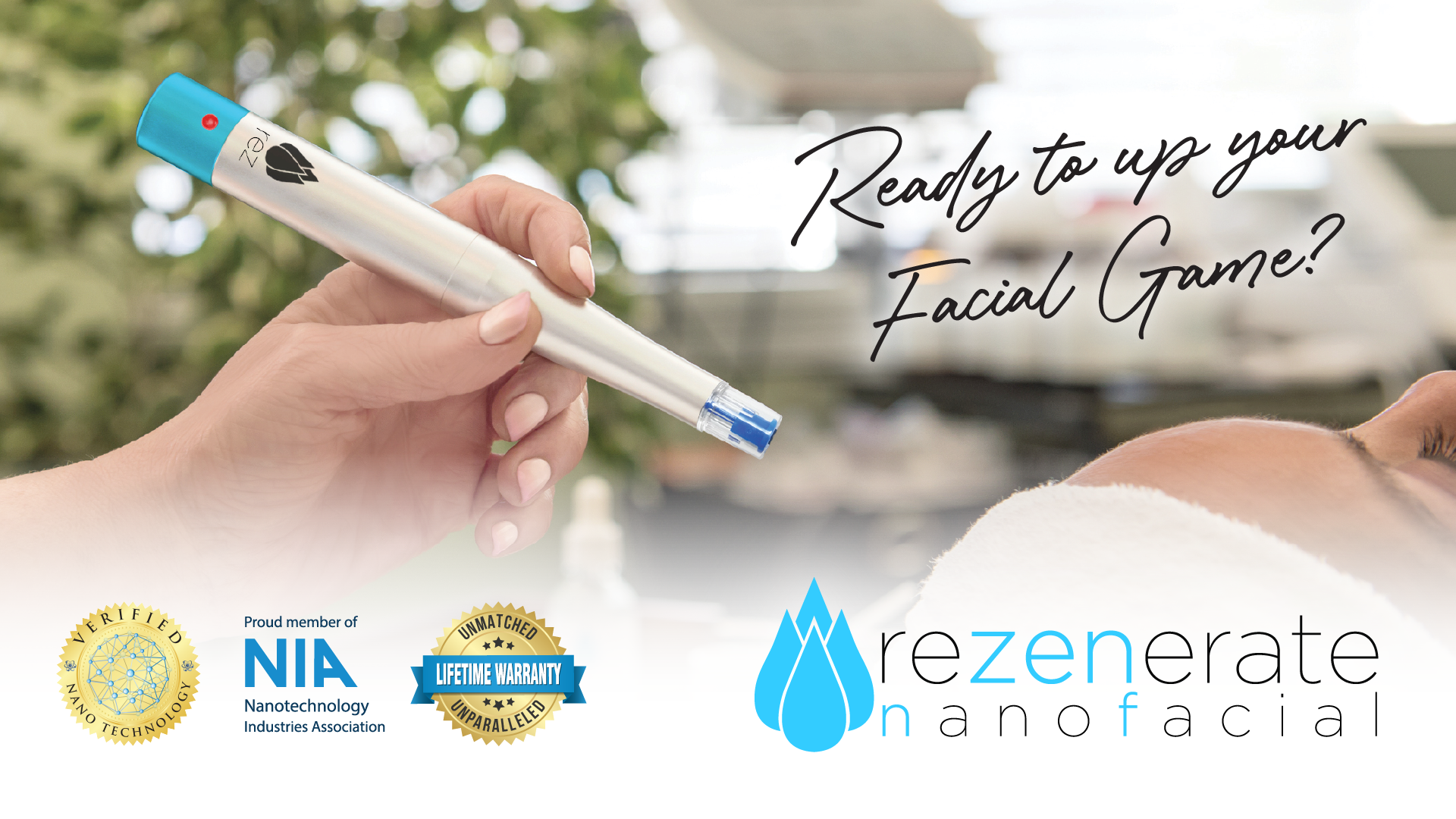Rezenerate CEO, Ryan Rabah shares on botanicals and nanotechnology
In recent years, a holistic approach to skincare has emerged. This is no great surprise as there has been an increasing awareness of how chemicals, including those potentially in skincare, can negatively affect our health. As such, plant-based natural skincare products and how best to deliver them into our skin are vital topics.
Presence of low level concentrations of potential reproductive or developmental toxicants, particularly phthalates, in cosmetics and personal care products have been reported by the Centers for Disease Control and Prevention (CDC). *1 Further, they found makeup, shampoo, skin lotion, nail polish, and other personal care products contain chemical ingredients that lack safety data, with studies indicating reproductive issues, pregnancy defects, and increased cases of breast cancer. *2 It has simply never been more important for skin care professionals to know the products they are using with their clients.

Contribution by Ryan Rabah – Rezenerate President and Founder
Ryan Rabah entered the esthetic world with the introduction of the award-winning Rezenerate nanotechnology modality and its revolutionary ‘NanoFacial’ in 2014. In addition to founding Rezenerate, Ryan is a licensed attorney with a focus on business issues and is a vocal proponent of esthetician rights. To that end, Ryan works on the Advisory Board of The Esthetician Connection (“The EC”), the premier networking platform for estheticians, and he collaborates with organizations worldwide that work to uphold the integrity of the skincare industry.
Brands Move To Botanical Ingredients
Skincare manufacturers have clearly moved towards an increased use of phyto-ingredients in their products in recent decades. Botanical ingredients may result from different processing methodologies of the same plant material, including plant extracts, expressed juices, tinctures, waxes, vegetable oils, lipids, plant carbohydrates, essential oils, as well as purified plant components, such as vitamins, antioxidants, and other substances with recognized biological activity. In 2011, approximately one-third of ingredients listed by the International Nomenclature of Cosmetic Ingredients (INCI) system were classified as “botanical extracts. *3”
There is overwhelming evidence showing the various benefits of botanicals for the health, texture, and quality of the skin. But perhaps just as important to what we are putting on the skin is how we are administering these ingredients. For years prevailing modalities for product delivery have been either too invasive, too ineffective, or too inflammatory. Enter nanotechnology. Just as botanicals are becoming the most sought after product ingredient niche, so too are nanotechnology facials or Nano Facials becoming the most sought after method for product delivery.
Nanotechnology Delivery Systems
No delivery systems are more cutting edge than authentic devices utilizing verified nanotechnology.
Nanotechnology is an innovative area of science that includes the design, characterization, production, and application of materials, devices, and systems by controlling shape and size at the nanometer scale (1–100 nm). *4 Nanotechnology is often incorrectly marketed or defined as simply ‘something very small.’ Unfortunately, this leads to manufacturers calling something a ‘Nano Facial’ when it isn’t using nanotechnology devices / tips at all.
9 Characteristics Of Nanotechnology
Here are some important characteristics for systems using verified, scientifically accurate nanotechnology:
1 The Nano Tips are not made out of steel.
2 The Nano Tips are 1000x smaller than any microneedle.
3 The Nano Tip is guaranteed authentic nanotechnology.
4 The Nano Device is not adjustable.
5 The Nano Device only fits one type of tip (Nano).
6 The Nano Facial is pain free, gently disrupting the stratum corneum.
7 The Nano Facial is product neutral – can be used with all product lines.
8 The Nano Facial is Fitzpatrick neutral – can be used on all skin tones.
9 The Nano Facial is modality neutral – can be used in conjunction with other modalities.
Results of Rezenerate NanoFacial Using Wicked Earth
Results of A Nano Facial
An actual Nano Facial offers immediate and long-term results that enhance product absorption and penetrate active ingredients, including botanical based products, into the skin for optimal skin restoration. “The industry average absorption rate is between 2 – 10%, but utilizing an authentic nanotechnology device increases absorption to upwards of 40 – 50%. *5” Increased absorption means lower back bar costs (i.e., it takes less product to complete a service) and more effective results (e.g., a higher delivery of the healthy ingredients discussed in this article).
3 Favorite Botanical Ingredients To Use In A Nano Facial
Botanical usage is dramatically on the rise. While any product you are looking to infuse will be delivered more effectively via a Nano Facial, here are three of my favorite botanical ingredients to infuse:
Jojoba
Simmondsia chinensis commonly known as jojoba belongs to family Simmondsiaceae and its oil is widely used in in cosmetic formulas. It contains a broad spectrum of fatty acids such as oleic, linoleic, linolenic, and arachidonic as well as triglycerides. In a study of the top 10 botanical ingredients in over-the-counter antiaging creams, Jojoba usage had increased from .56% to 11.65% (2010 to 2018). *6 Consumers really love it. There are various benefits to this plant ingredient, including combatting various skin irritations and acne, increasing wound healing, moisturizing dry skin, fighting oxidative stress, and working against skin aging. Adding a Nano Facial to the mix increases these benefits exponentially.
Shea
As of 2018, Butyrospermum parkii (shea, or Vitellaria paradoxa) had become the most used botanical in the aforementioned study. Shea had a percentage increase of usage from 5.65% to 15.53% since 2010. *7 Shea is mainly used for its butter, which consists of a solid fat extracted from mature shea fruit. It contains 90% triglycerides (saponifiable fraction) and 10% non-triglycerides (unsaponifiable fraction). Shea butter has shown to boost collagen production, reduce multiple signs of aging, and prevent photo-aging *8. Products containing shea butter are always a popular choice for a Nano Facial.
CBD
Perhaps no botanical ingredient has become more prevalent in skincare in recent years than CBD (cannabinoid cannabidiol). CBD helps inhibit flare ups in many skin conditions and offers a soothing touch to easily irritated skin. Incorporation of CBD in cosmeceuticals can help nourish skin and lock in moisture for a healthy and glowing face. *9 The discovery of a skin endocannabinoid system and its role in maintaining skin homeostasis, alongside the anti-inflammatory actions of cannabinoids, has raised interest in their use for the treatment of skin inflammatory [issues]. *10 There is no Nano Facial more requested in the spas I visit than those incorporating CBD infusion.
Skincare is constantly evolving and it is imperative for industry professionals to stay abreast of new innovations. Delivering nutrient-rich, safe botanical products utilizing an authentic nanotechnology Nano Facial is a trending treatment worth checking out.
Resources
- European Journal of Molecular & Clinical Medicine ISSN 2515-8260 Volume 08, Issue 04, 2021: A Review on Herbal Drugs as Skin Care Products, Yogita Ale, Ayush Kushwaha, Amandeep Singh.
- Ibid.
- Antignac, E.; Nohynek, G.J.; Re, T.; Clouzeau, J.; Toutain, H. Safety of botanical ingredients in personal care products/cosmetics. Food Chem. Toxicol. 2011, 49, 324–341.
- Frontiers in Chemistry, REVIEW www.frontiersin.org 3 November 2019 | Volume 7 | Article 739, Role of Nanotechnology for Design and Development of Cosmeceutical: Application in Makeup and Skin Care, Zarith Asyikin Abdul Aziz, et al.
- Rezenerate NanoFacial 2022 Presentation, Ryan Rabah, et al.
- International Journal of Pharmaceutical Research and Applications Volume 6, Issue 4 July-Aug 2021, pp: 1517-1522 www.ijprajournal.com ISSN: 2249-7781, Skin Care Potential of Selected Medicinal Plants- A Review, Abhinay Kumar Dwivedi.
- Ibid.
- Renard, F. Le Beurre de Karité; Université de Bordeaux: Bordeaux, France, 1990.
- Trends in Phytochemical Research (TPR): Cannabidiol (CBD) – An update, Satyajit D. Sarker and Lutfun Nahar, Journal Homepage: http://tpr.iau-shahrood.ac.ir
- Martins, A.M.; Gomes, A.L.; Vilas Boas, I.; Marto, J.; Ribeiro, H.M. Cannabis-Based Products for the Treatment of Skin Inflammatory Diseases: A Timely Review. Pharmaceuticals 2022, 15, 210. https://doi.org/10.3390/ph15020210


